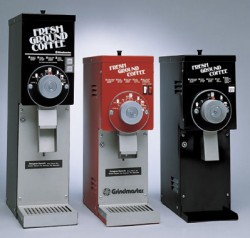
CFN – I find it gratifying that more and more people in the Cornwall area are starting to appreciate fresh roasted coffee. At least three lunch counters/coffee shops in Cornwall that I know of are now claiming to serve fresh roasted coffee. However, having fresh coffee available is just the first step. You have to brew it properly for it to be truly appreciated.
There are three basic components of making a pot of coffee; the coffee, the brewing device (coffee maker) and the water. The simplest one to explain is the water. Basically, if you won’t drink the water then don’t use it to make your coffee with it. Personally I use spring water in my coffee maker. I would never recommend using distilled water because it extracts far too much flavour out of the coffee, including all the nasty sour straw flavours that you get from cheap under roasted coffees found in certain coffee chains.
The type of coffee maker dictates how you grind the coffee. If you use an electric drip machine then the coffee should be ground so that a full pot is brewed in 4 -6 minutes, typically a medium grind will do. Espresso makers use espresso grind, percolators use a coarse grind, vacuum pots use extra coarse, French press uses medium coarse and manual drips use fine grind.
The coffee should be fresh roasted and fresh ground. At home you should use a coffee grinder to prepare your coffee just before you are going to use it. The cheap little whirling blade models will do but you can’t control the particle size and it typically grinds the coffee too fine for a regular electric drip machine. The best kind of grinder to use is called a burr grinder and is priced between $60 to over $100 for a home model. Of course commercial burr grinders can cost up to $5000 and more but most households don’t need commercial grinders. The grinders you see in most grocery stores or coffee shops are around $1000 new and can be limited in the type of grinds it will produce, typically not doing a very good job on espresso grinds or finer.

OK, now you have your purified or spring water, fresh ground coffee and a coffee machine in good operation and you are ready to brew a pot. But how much coffee do you use? This is where most good coffees go bad, making the brew too weak. You have to use enough coffee to extract all the good coffee flavour oils. If you brew a pot too strong then you can always dilute it with a little hot water but if it’s too weak then there is no way to fix it.
In my culinary classes back in 2000 the text we used, Professional Cooking 4th Edition by Wayne Gisslen, stated that:
“Recommended proportions are 1 pound of coffee and 1 ¾ to 2 ½ gallons of water, or 500 grams of coffee and 7.5 to 10.5 liters of water, depending on the strength. To make weaker coffee, add hot water after removing the used grounds.”
Today, brewing instructions from coffeeresearch.org are as follows:
“Procedure of Making Coffee: Directions
The following general rules apply to each coffee making process discussed. Coffee should be brewed for 4.5-5 minutes using a ratio of 55 grams of ground coffee per liter of filtered water (195-205°F). It is convenient to use 2 tablespoons of coffee per 6 ounces of filtered water. Filtered water and spring water are recommended. Tap water imparts off flavors to the coffee and some minerals are essential to coffee flavor. Distilled water is not recommended for brewing coffee as it lacks the minerals to bring out the natural flavors of the coffee.”
So there you have it. To make a good pot of coffee you need good water, fresh roasted and fresh ground coffee, a clean well functioning brewer, and the right amount of coffee (1-2 coffee spoons per 6 oz cup). It is always a good idea to actually measure the amount of water that fills your coffee pot. The coffee makers all seem to have a different idea of what the size of a cup is.
And finally, never leave the brewed coffee on a burner. It will turn nasty quickly. Either drink it all right away (if you are serving a number of people at once) or put it in a thermal carafe.
Now which coffee you should use is another topic all together.
For an entertaining review of coffee brewing methods check out this article in today’s Globe and Mail.







I love my new French Press!
Reg
How did the cold brewing process work out?
Thanks for your interest Smee but there is not a lot of call for iced coffee right now and I haven’t tried to develop a market for the coffee concentrate. I did buy a larger extraction unit but I haven’t even put it together yet.